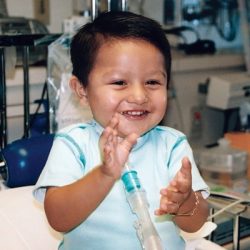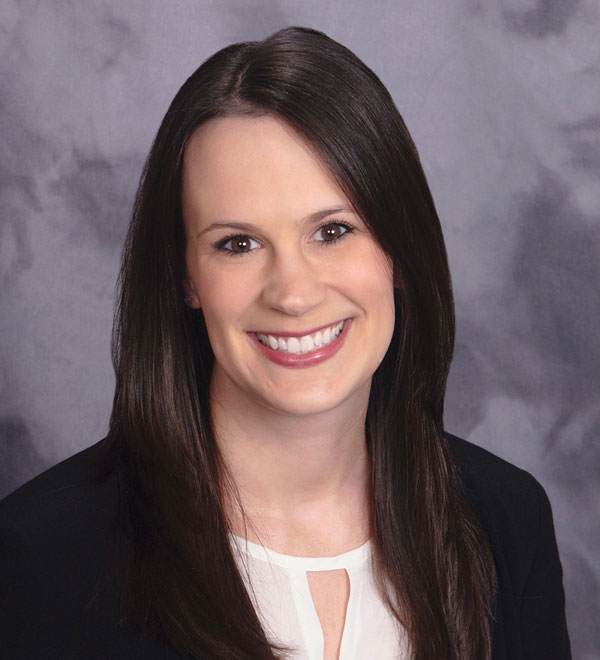Keys to Success: A Pediatric Respiratory Therapy Case Study
Lyndsi Yarkosky, RRT

Throughout infancy and childhood, gross and fine motor development progresses in a typical pattern and timeline which impacts many aspects of a child’s life. However, when infants and children are tracheostomized at a young age, this developmental process is negatively impacted. Placement of a tracheostomy tube in the child’s airway opens a previously closed system. While the tracheostomy is necessary to improve the respiratory status of the child, having a tracheostomy tube in place changes the dynamics of the aerodigestive system. The child now breathes through the tracheostomy tube and cannot use the upper airway effectively, especially if the tracheostomy tube cuff is inflated. This loss of airflow through the upper airway diminishes stimulation of the upper airway, causing changes in sensation, loss of subglottic pressure, negative impact on secretions and secretion management, changes in swallow function, loss of voicing, and other negative changes to functions. In addition, having an open system has been shown to have a negative effect on trunk support and core stability for mobility (Massery, 2014, 2006; Massery, Hagins, Stafford, Moerchen, & Hodges, 2013). It also reduces their ability to communicate and eat safely. Early intervention is imperative, as a disruption during this critical period may have significant impact on patients’ development, in particular to language and speech (Stevens, Finch, Justice, & Geiger, 2011). The sooner the clinical team is able to intervene, the risk for long term delays is decreased (Hofmann, Bolton, & Ferry, 2008).
Application of the Passy Muir® Tracheostomy and Ventilator Swallowing and Speaking Valve provides opportunities to close the system and restore airflow to the upper airway. The Passy Muir® Valve is a bias-closed position no-leak speaking valve that closes at the end of inspiration and remains closed throughout the expiratory cycle. By doing so, it allows a patient to breathe out through the mouth and nose, returning airflow to the upper airway. This assists in returning functions that were compromised when a tracheostomy tube is placed. Two of those functions critical to development for a young child are vocalizing and a typical swallowing pattern.
As a respiratory therapist (RT), it is wonderful to work with these children to enable them to eat and communicate again, but the primary focus of the RT is: (1) how can we wean this patient; and (2) where do we begin? At our pediatric rehabilitation hospital, we have had much success using the Passy Muir Valve as a weaning tool and resource for patients with a tracheostomy and on ventilators. Within The Children’s Institute of Pittsburgh, the respiratory therapists have seen use of the Passy Muir Valve assist with decreasing ventilator settings, decreasing or eliminating oxygen use, increasing trials off the ventilator, and as a stepping stone towards the discontinuation of mechanical ventilation in the decannulation process. Use of the Passy Muir Valve involves written policies, procedures, and guidelines. In addition, the clinical approach and techniques used by the multidisciplinary team are key contributions to successful weaning.
The respiratory system of the human body is intended to be a closed system that works on a pressure gradient. Many functions within the human body occur because of how these pressure gradients change. However, when a tracheostomy is placed, the system becomes open and pressure is lost. Typically, exhalation occurs against resistance through the upper airway and glottis, which provides for physiologic Positive End Expiratory Pressure (PEEP). PEEP is the amount of pressure that remains in the lungs at the end of exhalation and provides ventilation to the alveoli to assist with proper gas exchange. A tracheostomy tube places an opening within the airway which punctures the naturally closed and pressurized system. With an open system, the body cannot maintain a strong, natural PEEP. This pressure is important to sustain as it improves oxygen saturation levels, improves gas exchange, and restores Functional Residual Capacity (FRC – the normal volume of gas left in the lungs after exhalation) (Vanderford, 2002).
When a patient is on a ventilator, the ventilator may be used to supplement physiologic pressures by setting a PEEP on the ventilator (normal PEEP is 3-5 cmH2O) (Deakins & Myers, 2007). If a patient has a tracheostomy tube and is off the ventilator, then the ability to sustain sufficient PEEP is compromised and may impact oxygenation. In addition to changes in PEEP, an open system impacts the ability to have an effective cough. A more effective cough is produced with a closed system, which also facilitates secretion management.
Applying the bias-closed position, no-leak, one-way Passy Muir Valve to a tracheostomy tube closes the system, which returns the lungs to a more normal physiologic process (Sutt, Caruana, Dunster, Cornwell, Anstey, & Fraser, 2016). Using the Valve enables the patient to breathe through the upper airway during exhalation, which returns the respiratory system to a more normalized physiologic process and allows the patient to have restored physiologic PEEP by using the normal resistance of the vocal cords and upper airway. In order to restore this more naturalized system, patients with tracheostomies must first be evaluated for Passy Muir Valve candidacy.
Closing The System: Evaluation
Every tracheostomy patient who is admitted into our facility is evaluated immediately by the speech language pathologist (SLP) and RT for Valve use. If the patient is on a ventilator, the RT evaluates for stable ventilator settings, such as FiO2 < 60%, PEEP < 10 cmH2O, and Peak Inspiratory Pressure (PIP) < 40 cmH2O. The first parameter assessed is the medical stability of the patient, with the team considering if the patient is stable and appropriate to consider cuff deflation and potential Valve use. The patient also should be awake, alert, and attempting to communicate. Next, if the patient has a cuffed tracheostomy tube, tolerance of cuff deflation is assessed. After oral and tracheal suctioning, the RT uses slow cuff deflation, allowing the upper airway to become acclimated to the different sensations as airflow is returned to the upper airway (Hess & Altobelli, 2014). The next critical step is ascertaining that the upper airway is patent. Airway patency may be evaluated in one of two ways if the patient is on the ventilator: (1) by checking that airflow is going around the tracheostomy tube, up through the vocal folds, and out the nose and mouth by feeling for airflow or hearing a cough, throat clear, or vocal sound; and (2) checking for a change in the PIP. If PIP decreases, this decrease indicates a leak through the upper airway. Once a Valve is placed in-line, tidal volume (VT) can be used to slowly return the patient to their pre-cuff deflation PIP by increasing VT in small increments until at pre-cuff deflation PIP. If all of these factors are positive, then the team begins looking at the application process.
Keys to Successful Application
Step One: Building Trust
A key first step in the approach to placing a Passy Muir Valve, whether the patient is on or off the ventilator, is building trust. Throughout the course of a typical hospital stay, a child interacts with many team members coming in and out of the room, performing different procedures or introducing new treatments. It can be overwhelming for the parents or caregivers and intimidating to the children. Bonding and building a relationship with the family sets everyone up for success. When the child sees that their parent or caregiver is comfortable and trusting of a new face, the child is less likely to be anxious or fearful.
Building trust may take time and should be approached with both the child and the parent or caregiver. Depending on the age of the child, this may require a play-based approach, education at an age-appropriate level, and a slow approach to change. The parent or caregiver will need education and quality information to help them understand what is happening with their child. They also will need to understand the role of the team members. Establishing rapport and a level of trust among all of the participants is critical to a successful approach.
Step Two: Providing Education
Another crucial step in the key to success is education; making sure the parent or caregiver is on board and understands the benefits of the Passy Muir Valve. In addition to speech and swallowing, education about the additional benefits, such as secretion management and restoring physiologic pressure should be provided. Everyone should have a good understanding of what steps will be taken during the assessment. If the child is too young to understand what will be occurring, establishing rapport and comfort will assist with making the evaluation process more of a success.
Various techniques for providing education may be used. Education should occur with both the child and the parent or caregiver and may be provided by various clinical team members. Specialized pediatric clinical practitioners may be involved in providing education because those working in pediatrics will have specialized experience and training in child development and are familiar with techniques specific to emotional support and coping strategies. Any member of the team, from the SLP to the RT, will be involved in education. Resources specific to pediatrics and the Passy Muir Valves are available through the Toby Tracheosaurus™ Program from Passy-Muir, Inc. and the TRACHTOOLS™ App. These provide different methods to approach education, from using a stuffed animal with a tracheostomy to patient videos.
Step Three: Use of Distraction
The final key to success used with the pediatric population when placing a Passy Muir Valve is distraction. At times, when a child is stressed or anxious, being able to provide a distraction from the intended plan may assist with improving participation and increase success rate. The use of distraction often requires the team to get creative with children and find age-appropriate activities or ideas that interest them.
The distraction helps to take their mind off the “new procedure,” decreasing fear and anxiety. Another option for distraction is to take the child out of the current setting. If a hospital patient room has been the only environment, the child may benefit from going to the gym or to an outside area to experience new scenery. Another aspect related to distractions is to limit extraneous stimuli, such as noises, lights and interruptions, which also may help to improve the child’s ability to participate.
One Child’s Story
Our multidisciplinary team consists of respiratory therapists, speech-language pathologists, recreational therapists, nurses, and physicians. We also consider the patient, family, and parent or caregiver an integral part of the team. In addition to the combined clinical skills of the multidisciplinary team, we focus on using the three keys to success: trust, education, and distraction. Usage of these techniques played a significant role in treating and weaning one of our recent challenging patients who was dependent on a tracheostomy and ventilator.
Noah is a 12 year old male who presented to the emergency department on May 31, 2016 with weakness. He suffered a spinal cord stroke, with fluid pinching his spinal cord, preventing blood flow to his brain. The fluid accumulation stemmed from his underlying birth diagnosis of Chiari Malformation, a structural defect in the cerebellum at the level of the foramen magnum. Noah also had a history of migraines, asthma, and anxiety. He was admitted to the hospital, and surgery was performed to remove the fluid and decompress the spinal cord, but he remained paralyzed from the neck down as a result of the stroke.
During his hospital stay, Noah was tracheostomized on June 6, 2016 with a #4 Shiley Disposable Cuffed Tracheostomy Tube. In need of intense rehabilitation, Noah was referred to The Children’s Institute of Pittsburgh and transferred to the pediatric rehabilitation hospital on June 29, 2016. The team at The Children’s Institute established several primary goals: (1) to wean him from his ventilator; (2) to provide education; (3) to train the patient and his mother; and (4) to initiate extensive therapies in the disciplines of physical therapy, occupational therapy, speech-language pathology, and respiratory therapy.
At the time when the RT and SLP began working with Noah, he was on the Trilogy Ventilator with settings of: SIMV/PC, PC 22 cmH2O (centimeters of water pressure), RR 16 bpm (breaths per minute), PEEP 8 cmH2O, PS 8 cmH2O and 2l pmO2. SIMV (Synchronized Intermittent Mandatory Ventilation) is a common mode of ventilation that ensures the patient is getting the minimum set ventilation but also allows the patient to take spontaneous breaths. This mode is a moderate support mode and is typically comfortable for the patient. Pediatric patients are normally ventilated with set pressures to achieve desired volumes, instead of set volumes, in order to help prevent barotrauma to the lungs (Dahlem & Randolph, 2015). At the time of admission to our facility, Noah was on a Pressure Control (PC) of 22 cmH2O, which is a normal inspiratory pressure for the lungs and his Respiratory Rate (RR) was set at 16 bpm. If he took additional breaths on his own above what the ventilator was supplying, we had a Pressure Support (PS) of 8 cmH2O set to help give his spontaneous breaths a boost. So, if Noah was breathing 20 bpm, 16 of those breaths were at the PC 22 cmH2O and the other 4 were at a PS of 8 cmH
Due to the patient’s underlying issues with anxiety, the initial stages of cuff deflation and vent weaning presented a huge challenge. With the cuff still inflated, Noah was unable to vocalize and did not have an easy method to communicate with staff or family, which added to his frustration. Whenever a member of the team would try to work with him, his respiratory rate and heart rate would increase as he would become tearful and anxious with possible change.
Our unspoken motto in the facility is “slow and steady wins the race.” We needed to set Noah up for success. It was very clear from the beginning of working with Noah that we needed to approach his care with a variety of methods and instituting our keys to success. To increase our chances of success, we began by building trust, explaining the plan, and letting him begin to know the team members. Another consideration was to have his mother become involved with the therapies to help with his anxiety. Having his mother educated on the plan and providing support was a key element to success.
During this step, it was essential to maintain a consistent team, which would assist with building trust. We integrated his speech, respiratory, and recreational therapy into interdisciplinary sessions, while pursuing cuff deflation and ventilator weaning. The team spent time taking Noah outside, and therapy began with sitting and talking about cars and some of his other interests. Once he became comfortable sitting outside, we would SLOWLY deflate his cuff and let him acclimate to the sensation of air moving through his nose and mouth – something he had not felt in a while. Typically, with patients, cuff deflation would occur over a minute or two to avoid a huge rush of air to a sensitive area. However, with Noah, it took approximately 10 minutes to get the cuff fully deflated. We did this twice a day for three days, until he was comfortable with the change in the feeling and with the team members working with him.
After we had successful tracheostomy cuff deflation, it was time to introduce the bias-closed position no-leak Passy Muir Tracheostomy & Ventilator Swallowing and Speaking Valve (PMV). Noah’s ventilator settings were stable, he wanted to eat and speak again, and we had confirmed his upper airway was patent by hearing whispers of speech after his cuff deflation. However, the team met with similar obstacles when using the PMV as they had with cuff deflation. Noah was hesitant and anxious about something new, which would cause a change in his breathing.
The first time we placed the PMV in-line with the ventilator, Noah agreed to use it for 10 minutes. Another consideration for success with children is to have them invested in the therapy; have them agree and assist with planning the goals. While there was much hesitation from Noah, having him assist with the plan, understand it, and using distraction while providing encouragement helped to motivate his use for 10 minutes. While it was not the easiest 10 minutes, Noah enjoyed having his voice back and being able to try tastes of Nutella. The ventilator settings for the initial Valve use were: SIMV/PC, PC 22 cmH2O, PEEP 8 cmH2O, PS 8 cmH2O, RR 8 bpm. Alarms were set at low minute ventilation 0.5 l/min and circuit disconnect 5 seconds (high and low pressures are automatically set at 5 above and below in SIMV/PC mode). Due to the Trilogy Ventilator leak compensating in pressure modes, no changes were made to the settings or alarms.
Over the next week, Noah’s use of the Valve steadily increased until he was using it all day. By this point, Noah also tolerated his tracheostomy cuff being deflated around the clock, 24 hours a day. He was medically stable and appropriately ventilated with the tracheostomy cuff deflated because of the leak compensation with the Trilogy ventilator. To increase the space around his tracheostomy tube within the diameter of the trachea and avoid unnecessary complications of the tracheostomy cuff, he was transitioned to a cuffless tracheostomy tube as soon as possible. The change introduced a Shiley cuffless tracheostomy tube (4 DCFS). Again, the Trilogy ventilator leak compensates when in pressure modes, so when the cuff is deflated or a valve is placed in-line, the Trilogy ventilator automatically adjusts to continue to deliver the set pressure. If the patient uses a different mode or a different ventilator, adjusting the pressure or volumes to pre-cuff deflation values will assist in compensating for the air leak. While this may be especially advantageous with pediatric patients, when working with older or anatomically larger patients, the ventilator may require a switch in mode and settings to provide compensation for the leak.
As Noah wore the PMV, his ventilator settings were reduced over the next two weeks to BiPAP settings (a spontaneous, weaning mode). Once Noah had been comfortable on the BiPAP settings, it was decided to trial the tracheostomy mask. The RT removed him from the vent and placed him on a room air tracheostomy mask with humidification. Within one minute, Noah’s SpO2 dropped from 98 to 87% and he struggled to breathe. After the RT bagged him and returned his SpO2 to baseline, he was placed back on the ventilator. After several minutes on the ventilator, Noah calmed down and was able to catch his breath. He stated that the feeling was so different off the ventilator, and he was scared because he could not talk.
We explained that we took him from a closed system (because he had the PMV in-line with the ventilator) to an open system, and his lungs lost a lot of pressure that the ventilator was previously providing him. As a result of Noah being scared during his first trial off the ventilator, it was a few weeks before he agreed to try again. The initial unsuccessful trial caused a setback for his weaning process.
When he finally became comfortable with the idea being off the ventilator again (still on BiPAP settings), we presented him with a new plan. We would remove him from the ventilator and place him on his PMV immediately, skipping the tracheostomy mask. We explained the reasons to him. First, being the most important to him was that he would be able to talk, which would assist with being less anxious. The second main reason to place the PMV immediately was so that his lungs did not lose pressure. As previously discussed, the lungs operate with PEEP under a closed system. When Noah was trialed with a tracheostomy mask and no PMV, he had an open system and could not sustain his own natural physiologic pressures. His oxygenation dropped, and he felt his breathing was compromised. The plan this time was to use the Passy Muir Valve immediately with removal of ventilation, so that a closed system would be maintained. Noah was in agreement to let us remove him from the ventilator and to place the PMV.
Upon doing this, the team anticipated his typical anxious reaction; however, his response was surprising and instead he voiced, “I feel fine.” The team was so excited – this was a successful trial! He was able to be off the ventilator and use the PMV for 15 minutes during his first trial. Over the next month, we were able slowly to build his strength and endurance, and Noah was off the ventilator for 2.5 hours, twice a day, at the time of discharge home. He was happy that he did not have to use his ventilator while at school.
Achieving Success
Success with this patient did not come easily or quickly, but by implementing our techniques of building trust, providing education, and using distraction techniques, our efforts with Noah were successful. It took extra patience and creativity on our end (which is typical when working in pediatrics) and a lot of trust and patience on Noah’s end. Understanding from the beginning that we needed to be aware of our approach and take our time, helped us all in the long run. We also will now consider our best practice of “tracheostomy mask trials.” Working with Noah demonstrated to the team the need to have a closed system to establish use of a more natural physiologic PEEP, and return a patient’s ability to use their upper airway and sustain their oxygenation when transitioning off the ventilator. Transitioning from ventilator to tracheostomy mask has its own complications to consider and implementation of the PMV to maintain a closed system appears to assist with both patient comfort and improved respiratory support. It not only made a difference in how the patient felt, but it improved how his lungs responded to the change and weaning process.
This article is from the Fall 2017 Pediatric Issue of Aerodigestive Health. Click here to view Keys to Success: A Pediatric Respiratory Therapy Case Study.
References:
Dahlem, P. and Randolph, A.G. (2015). Pediatric acute lung injury. PC Rimensberger (ed.), Pediatric and Neonatal Mechanical Ventilation, 1279-1290. doi:10.1007/978-3- 642-01219-8_49, Springer-Verlag Berin Heidelberg.
Hess, D.R. and Altobelli, N.P. (2014). Tracheostomy tubes. Respiratory Care. 59(6) 956-971. doi:10.4187/respcare.02920
Hofmann, L., Bolton, J., and Ferry, S. (2008). Passy-Muir speaking valve use in a children’s hospital: An interdisciplinary approach. Perspectives: ASHA, 18(2), 76-86. doi:10.1044/vvd18.2.76
Massery, M. (2014, February 03). Clinical expert interview: The role of the Passy-Muir Valve in physical therapy. Talk Muir, 2-4.
Massery, M. (2006). Multisystem consequences of impaired breathing mechanics and postural control in cardiovascular and pulmonary physical therapy evidence and practice. (4th ed.) In Frownfeter, D. & Dean, E., (Eds.) St. Louis, MO: Elsevier Health Sciences, 695.
Massery, M., Hagins, M., Stafford, R., Moerchen, V., and Hodges, P.W. (2013). Effect of airway control by glottal structures on postural stability. Journal of Applied Physiology, 115(4), 483-490. doi:10.1152/japplphysiol.01226.2012
Deakins, K.M. and Myers, T. Selecting Appropriate Ventilator Parameters. Retrieved from rtmagazine.com/2007/02/selecting-appropriate-ventilator-parameters/
Stevens, M., Finch, J., Justice, L., and Geiger, E. (2011). Use of the Passy-Muir Valve in the neonatal intensive care unit. Neonatal Intensive Care, 24(7), 22-23.
Sutt, A., Caruana, L.R., Dunster, K.R., Cornwell, P.L., Anstey, C.M., and Fraser, J.F. (2016). Speaking valves in tracheostomised ICU patients weaning off mechanical ventilation – do they facilitate lung recruitment? Critical Care, 20(1), 91. doi:10.1186/ s13054-016-1249-x
Vanderford, P.A. (2002). Chapter XIV.5. Mechanical Ventilation: Case Based Pediatrics for Medical Students and Residents. Department of Pediatrics, University of Hawaii. John A. Burns School of Medicine. Retrieved from https://www.hawaii.edu/medicine/ pediatrics/pedtext/s14c05.html











